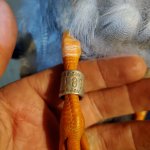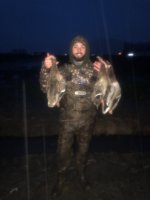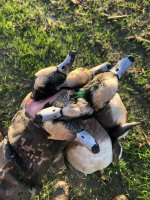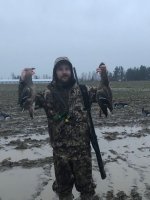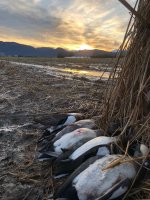Hoffer
FNG
- Joined
- Jul 19, 2020
- Location
- British Columbia
Hey everyone,
Wanted to get on here and share about some of the successful duck hunts I've been able to have over the season. As a newbie in the realm of hunting (my buddy as well) this bird season was my first real successful season in putting birds in the freezer. After a bit of door knocking I managed to secure a great spot to hunt on a private farm, hunting over a cut corn field that floods in the rolling depressions with all the winter rain here in the lower mainland of BC. We have been running anywhere from 12-28 mallard decoys including a mojo and a diver. It's been a great season of learning, spending hours in the blind even on slow days trying to get a grasp on behaviour and the different factors that will affect just what the heck the ducks decide to do. In short, duck hunting has become a borderline problematic addiction!
With that being said, we are struggling to get the geese to cooperate with us. We are running five dozen Dive Bomb silhouette decoys in the field and we are about 500 yard away from a huge river (fraser river) that is adjacent to the field, have been experimenting with different shapes based on what the winds doing(U, broken U, X). We're having the same outcome everytime, we manage to get the birds attention through calling and waving the flags, they will drop down significantly, lock up and continue to effortlessly flutter downward in the wind, then out a few hundred yards they will flare hard and bail, rarely ever coming back for a second glance. I know its late in the season and these birds have been seeing spreads for months now...wondering if they are seeing us shuffle around in the blind? Would be great to hear what any of you experienced waterfowlers have to say about things to fine tune for the honkers this late in the game!
Wanted to get on here and share about some of the successful duck hunts I've been able to have over the season. As a newbie in the realm of hunting (my buddy as well) this bird season was my first real successful season in putting birds in the freezer. After a bit of door knocking I managed to secure a great spot to hunt on a private farm, hunting over a cut corn field that floods in the rolling depressions with all the winter rain here in the lower mainland of BC. We have been running anywhere from 12-28 mallard decoys including a mojo and a diver. It's been a great season of learning, spending hours in the blind even on slow days trying to get a grasp on behaviour and the different factors that will affect just what the heck the ducks decide to do. In short, duck hunting has become a borderline problematic addiction!
With that being said, we are struggling to get the geese to cooperate with us. We are running five dozen Dive Bomb silhouette decoys in the field and we are about 500 yard away from a huge river (fraser river) that is adjacent to the field, have been experimenting with different shapes based on what the winds doing(U, broken U, X). We're having the same outcome everytime, we manage to get the birds attention through calling and waving the flags, they will drop down significantly, lock up and continue to effortlessly flutter downward in the wind, then out a few hundred yards they will flare hard and bail, rarely ever coming back for a second glance. I know its late in the season and these birds have been seeing spreads for months now...wondering if they are seeing us shuffle around in the blind? Would be great to hear what any of you experienced waterfowlers have to say about things to fine tune for the honkers this late in the game!

